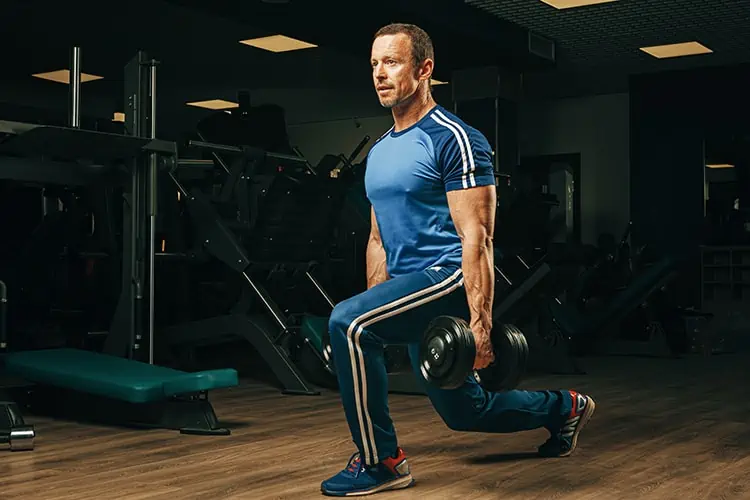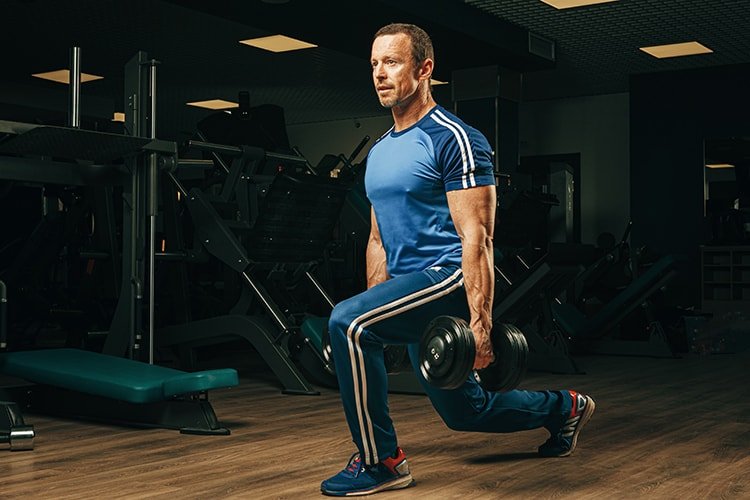
The dumbbell lunge is a popular strengthening exercise that targets various muscle groups in your lower body, including your quads, hamstrings, glutes, and calves. It also engages your core and helps improve your balance and coordination. In this comprehensive guide, we’ll walk you through the steps to perform dumbbells correctly, discuss variations to improve your workout routine, and offer tips to ensure you’re getting the most out of this versatile exercise.
Understanding the Basics of Dumbbell Lunges
Before diving into the specifics of the dumbbell, it is essential to understand the basics of this exercise to maximize its benefits and minimize the risk of injury.
What are Dumbbell Lunges?
Dumbbells are a variation of the traditional exercise, performed with a dumbbell in each hand. This addition of weight intensifies the workout, further engaging the muscles and increasing the challenge.
Why Include Dumbbell Lunges in Your Routine?
Incorporating dumbbells into your workout routine can improve muscle strength, endurance, and balance. This exercise not only strengthens the legs but also improves core stability and posture. Its unilateral nature helps identify and correct imbalances between the legs, making it a valuable addition to any exercise program.
Step by Step Guide to Performing Dumbbell Lunges
To ensure safety and effectiveness, follow these detailed steps when performing dumbbells:
Starting position
- Select the appropriate weights: Start with lighter dumbbells to focus on form before moving on to heavier weights.
- Stand tall: Stand with your feet hip-width apart, holding a dumbbell in each hand by your sides. Roll your shoulders back and down and engage your core.
The Lunge
- Step forward: Step forward with one leg, keeping the dumbbell steady at your sides.
- Lower your body: Lower your body until your front thigh is parallel to the ground and your back knee is close to touching the floor. Make sure your front knee doesn’t go past your toes.
- Press down: Push off the heel of your front foot to return to the starting position.
Repetition and sets
- Repeat: Perform the desired number of repetitions on one leg before switching to the other. Aim for 3-4 sets of 8-12 reps per leg, depending on your fitness level.
Variations to challenge yourself
Once you’ve mastered the basic dumbbell walk, consider incorporating these variations to challenge yourself further and keep your workouts exciting:
Reverse Dumbbell
Instead of taking a step forward, take a step back into the lunge. This variation puts less stress on the knees and targets the glutes and hamstrings more strongly.
Walking Dumbbell Lunges
This dynamic version involves stepping forward into a lunge and then stepping directly into another lunge with the opposite leg, stepping forward with each repetition. It’s great for building endurance and coordination.
Side dips
Step to the side instead of forward, targeting the inner and outer thighs. This variation helps improve lateral movement and stability.
Key tips for success
To get the most out of dumbbells and prevent injury, keep these tips in mind:
- Maintain proper form: Always prioritize form over weight. Incorrect form can lead to injuries and reduce the effectiveness of the exercise.
- Check your movement: Perform each walk with control, especially when lowering your body. Avoid jerky movements to maintain balance and engage the right muscles.
- Breathe: Inhale as you lower your body and exhale as you push up. Proper breathing helps maintain stability and stamina.
- Gradual progress: Increase the weight of the dumbbells gradually as you become more comfortable with the exercise. Jumping to heavier weights too quickly can compromise your form.
Techniques to improve your dumbbells
To further enhance the benefits of dumbbells, consider incorporating these advanced techniques into your workout:
Eccentric Lunges
Eccentric lunges focus on slowing down the phase where you lower your body to the ground. By extending this phase to 3-5 seconds, you increase muscle tension and stimulate growth, improving both strength and endurance.
Plyometric bulbs
Also known as jump lunges, this variation adds an element of cardiovascular and explosive strength to the exercise. After lowering into the lunge, explode upward, switching legs in the air, and land in a lunge with the opposite leg forward. This variation is particularly effective for enhancing strength and agility.
Isometric Reservations
At the bottom of the roller, hold the position for a set duration, usually 5-10 seconds, before pushing back up. This isometric hold increases muscle activation and endurance, making your workout more challenging.
Common Dumbbell Lunges Mistakes to Avoid
To ensure the effectiveness of your dumbbells and reduce the risk of injury, be careful to avoid these common mistakes:
Exaggerations
Taking too long a step can strain your knees and lead to imbalance. Make sure your stride is long enough that your front thigh is parallel to the floor without extending your knee past your toes.
Lean forward
Keep your torso upright throughout the exercise. Leaning forward too much can put undue stress on your back and shift the focus away from the target muscles.
Neglecting the Core
Engaging your core is crucial to maintaining balance and stability during flights. Failure to engage your core can lead to wobbly posture and reduced exercise effectiveness.
Rushing Through Reps
Doing lunges too quickly can compromise your form and reduce the effectiveness of the exercise. Focus on controlled movements to maximize muscle engagement and minimize the risk of injury.
The Benefits of Dumbbell Lunges
Dumbbells offer a multitude of benefits, making them a must-have in your workout routine. Here are some of the key benefits:
Enhanced lower body strength
Targeting the quadriceps, hamstrings, glutes and calves, dumbbells increase lower body strength.
Improved balance and coordination
The unilateral nature of the lungs requires balance and coordination, which improves proprioception and stabilizes the muscles.
Increased core stability with Dumbbell Lunges
Maintaining an upright posture during flights engages your core muscles, enhancing your overall stability and posture.
Muscle imbalances corrected
Performing dips on each leg separately helps identify and correct imbalances, reducing the risk of injury and improving symmetry.
Flexibility and convenience
Dumbbells can be performed almost anywhere, requiring only one set of dumbbells. This makes them an affordable exercise option for people of all fitness levels.
Dumbbells are a flexible, effective and dynamic exercise suitable for people of all fitness levels. By incorporating variations, focusing on form and gradually increasing intensity, you can reap the benefits of improved strength, balance and muscular endurance. Remember to listen to your body and progress at your own pace to ensure a safe and effective training experience. Whether you’re looking to improve your athletic performance or simply build a stronger, more balanced physique, dumbbells are a great addition to your training arsenal.
